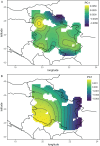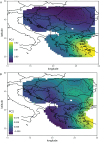Influence of honey bee (Apis mellifera) breeding on wing venation in Serbia and neighbouring countries
- PMID: 38685938
- PMCID: PMC11057427
- DOI: 10.7717/peerj.17247
Influence of honey bee (Apis mellifera) breeding on wing venation in Serbia and neighbouring countries
Abstract
In order to improve the productivity of honey bees (Apis mellifera), some of their traits are selected by breeding. On one hand, breeding is mainly based on the natural geographical variation of this species; on the other hand, mass production and distribution of artificially selected queens can significantly affect the natural geographic variation of honey bees. In this study, we have compared honey bee wings originating from breeding and non-breeding populations in Serbia. In the comparison, we have also used data from a large area of south-eastern Europe. The wings were measured using the 19 landmarks indicated on the wing images. The coordinates were analysed using the methodology of geometric morphometrics. We found that honey bees obtained from honey bee queen breeder differed in wing venation from surrounding populations, which are under natural selection. Therefore, we argue against including populations under artificial selection in the analysis of the natural geographical variation of honey bees. In our analysis of non-breeding samples, we found that in south-eastern Europe there is continuous variation in wing venation and no clear boundaries between A. m. carnica, A. m. cecropia, and A. m. macedonica.
Keywords: Apis mellifera; Breeding; Honey bee; Serbia; Wing.
© 2024 Kaur et al.
Conflict of interest statement
The authors declare that they have no competing interests.
Figures






Similar articles
-
Honey bee (Apis mellifera) wing images: a tool for identification and conservation.Gigascience. 2023 Mar 20;12:giad019. doi: 10.1093/gigascience/giad019. Epub 2023 Mar 27. Gigascience. 2023. PMID: 36971293 Free PMC article.
-
Biogeographic study of the honey bee (Apis mellifera L.) from Serbia, Bosnia and Herzegovina and Republic of Macedonia based on mitochondrial DNA analyses.Genetika. 2010 May;46(5):685-91. Genetika. 2010. PMID: 20583605
-
Historical Changes in Honey Bee Wing Venation in Romania.Insects. 2021 Jun 10;12(6):542. doi: 10.3390/insects12060542. Insects. 2021. PMID: 34200932 Free PMC article.
-
Beekeeping Genetic Resources and Retrieval of Honey Bee Apis mellifera L. Stock in the Russian Federation: A Review.Insects. 2021 Jul 29;12(8):684. doi: 10.3390/insects12080684. Insects. 2021. PMID: 34442250 Free PMC article. Review.
-
Climate change: impact on honey bee populations and diseases.Rev Sci Tech. 2008 Aug;27(2):485-97, 499-510. Rev Sci Tech. 2008. PMID: 18819674 Review. English, French.
References
-
- Baken EK, Collyer ML, Kaliontzopoulou A, Adams DC. geomorph v4.0 and gmShiny: enhanced analytics and a new graphical interface for a comprehensive morphometric experience. Methods in Ecology and Evolution. 2021;12(12):2355–2363. doi: 10.1111/2041-210X.13723. - DOI
-
- Bienefeld K. Breeding success or genetic diversity in honey bees? Bee World. 2016;93(2):40–44. doi: 10.1080/0005772X.2016.1227547. - DOI
-
- Büchler R, Andonov S, Bienefeld K, Costa C, Hatjina F, Kezic N, Kryger P, Spivak M, Uzunov A, Wilde J. Standard methods for rearing and selection of Apis mellifera queens. Journal of Apicultural Research. 2013;52(1):1–30. doi: 10.3896/IBRA.1.52.1.07. - DOI
-
- Büchler R, Costa C, Hatjina F, Andonov S, Meixner MD, Conte YL, Uzunov A, Berg S, Bienkowska M, Bouga M, Drazic M, Dyrba W, Kryger P, Panasiuk B, Pechhacker H, Petrov P, Kezić N, Korpela S, Wilde J. The influence of genetic origin and its interaction with environmental effects on the survival of Apis mellifera L. colonies in Europe. Journal of Apicultural Research. 2014;53(2):205–214. doi: 10.3896/IBRA.1.53.2.03. - DOI
Publication types
MeSH terms
LinkOut - more resources
Full Text Sources

